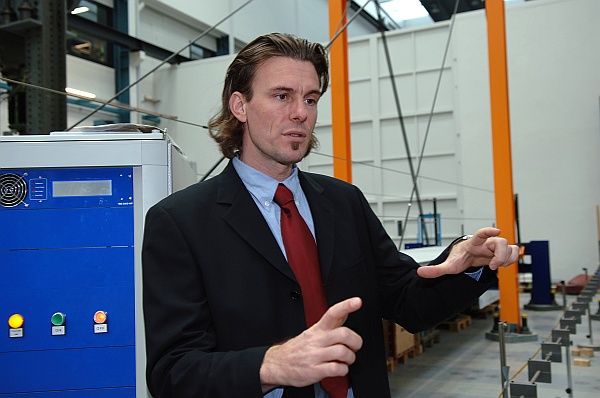|
The 39-year old, a Swabian by birth, took over Empa's
Communications Section on 1 December last year. After all the years
spent behind the editor's desk, he is happy that he now gets closer
to research again. As science editor of the SonntagsZeitung, with
Science and working as a freelancer, he spent seven years
researching and reporting on themes related to life sciences,
«but that included everything, from cloning and medical
topics to paleontology, anthropology and behavioral science».
His «beat» also covered environmental themes such as
ecology and climate.
First «calling»: biochemist
His studies took him away from his home town of Heilbronn
in 1987, firstly to the University of Bayreuth, then, after first
diploma in biochemistry, to the ETH in Zurich. There, he gained a
master’s in the Laboratory for Experimental Immunology under
Rolf Zinkernagel, at that point yet to be awarded his Nobel Prize.
At the Institute for Molecular Biology of the University of Zurich,
he worked from 1992 – 1997 on his dissertation under the
guidance of Walter Schaffner on the subject of problems in gene
regulation and genetic recombination of, among other things, the
herpes-simplex virus.
The desire to become a science journalist
After having written numerous scientific papers on
molecular biology, he decided that «Everything to do with
writing for scientific publications seems easy to me, even in
English». Science as a subject matter was for him, as it had
always been, one of the most fascinating areas there is. That is
why Hagmann crossed the Atlantic after a short postdoc research
phase. He was accepted for the ‘Postgraduate Program in
Science Communication’ at the University of California in
Santa Cruz (UCSC) – the only member of the group without
English as his mother tongue. There, he learnt the craft of writing
professionally from scratch; he wrote for the local press about
crazy demonstrators on Veteran’s Day, about fertilizer for
lettuce and strawberries in the Salinas Valley, and produced
contributions for a local radio station on the questionable felling
of the mighty redwoods. Thus equipped, he took on a short-term
contract in 1998 with Discover in New York and joined Science in
Washington, after graduating from UCSC, to become a certified
science journalist. He then advanced, on the return to Europe, to
the position of European science correspondent for Science in
Cambridge.
Same career, different tools
Fate appeared to want Hagmann to return to Switzerland. In
2000, the SonntagsZeitung offered him the job of science journalist
on the editing team. For five years he worked there, but spent also
time working as a freelance consultant, either in terms of
communication affairs in EU research programs or for the creation
of a new degree program in science communication in Germany.
Hagmann views the step from science editor to head of
communications at Empa as a welcome change of scenery with the
potential for a steep learning curve. When asked what he expects of
his work, he thinks «The political dimension of research is
what attracts me most to public work for a research
institute». He is, however, intrigued as to how communication
can be used by Empa in its capacity as a creator of identity. He is
not least happy about supporting other researchers by making their
results known to a wider public. Fame, honor and research money
will only be available if successful results come into the public
domain. Because, as he says, laughing, «There’s nothing
in it for me if no one becomes any the wiser».
|

